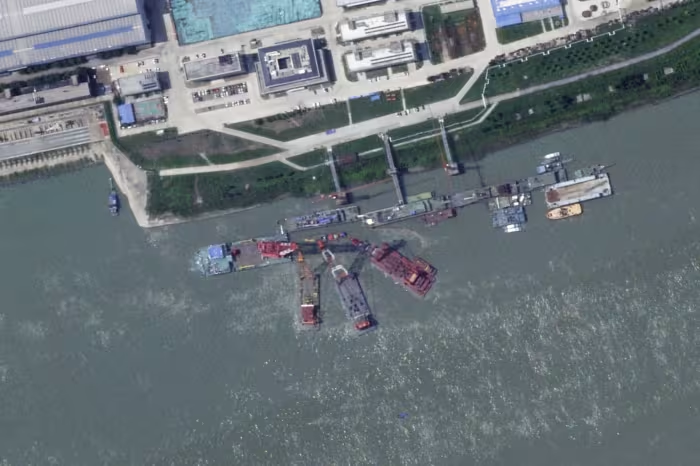
Satellite imagery reveals that a new Chinese nuclear-powered attack submarine sank during construction, raising questions about the country’s naval prowess and its efforts to expand its military presence.
A senior U.S. defense official confirmed on Thursday that a Zhou-class nuclear submarine, China’s newest and most advanced attack submarine, sank alongside a pier while under construction. This revelation comes as China continues to bolster its military capabilities, with a particular focus on its navy.
According to satellite images analyzed, the incident occurred sometime between May and June. These images show cranes and rescue equipment surrounding the submerged vessel, indicating an attempt to salvage it. While the cause of the sinking remains unclear, it represents a significant setback for China’s ambitious naval modernization program.
A Hidden Disaster
“It’s not surprising that the PLA Navy would try to conceal the fact that their new first-in-class nuclear-powered attack submarine sank pierside,” said a senior U.S. defense official. “In addition to the obvious questions about training standards and equipment quality, the incident raises deeper questions about the PLA’s internal accountability and oversight of China’s defense industry, which has long been plagued by corruption.”
International Concerns
The sinking of a nuclear submarine, particularly one under construction, has raised concerns about potential radiation leaks and the safety of Chinese naval operations. While no reports of radiation release in the area have been reported, experts have emphasized the potential long-term consequences.
“This sort of thing is not just an ordinary accident. It involves nuclear submarines,” stated Ashok Swain, a professor of peace and security at the University of Uppsala. “When these accidents take place in the water, particularly, it can potentially affect a larger community. If there is a leak, we will see the radiation moving to other parts of the world through moving waters. It is a matter of international concern.”
A Blow to Chinese Ambitions
The sinking of the Zhou-class submarine marks a significant setback for China’s naval ambitions. It has been actively expanding its submarine fleet to challenge the United States’ dominance in the Pacific region. The incident raises questions about the quality of its naval shipbuilding and the reliability of its submarine technology.
“It is a major error in letting it sink. It has slowed down Chinese military efforts in the months since,” stated Brent Sadler, a retired US Navy nuclear submarine officer and senior research fellow at the Heritage Foundation.
A Larger Trend?
The incident also coincides with a growing list of reported mishaps within the Chinese military, including a submarine accident in October 2023 where 55 sailors were feared to have died. These incidents have sparked concerns about the overall effectiveness and safety of China’s military forces and the transparency of its operations.
While China has not publicly acknowledged the Zhou-class submarine sinking, the event has heightened international attention on its military programs and its growing influence in the Asia-Pacific region. The sinking highlights the complexities and risks of rapidly expanding military capabilities, particularly those involving sensitive technologies like nuclear power.
